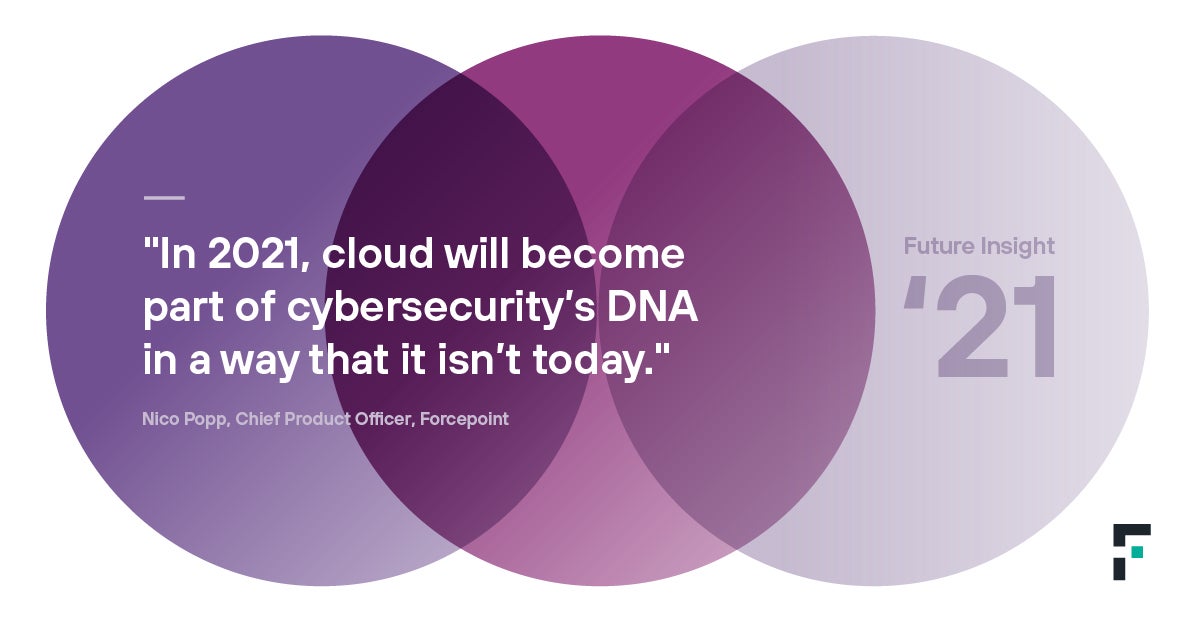Future Insights – The Emergence of the Zoom of Cybersecurity
This is the status quo today: We have all moved to remote working. Cloud deployment is a necessity. Digital transformation has happened—and where it hasn’t, it needs to.
I always love looking towards the future, but in 2020 it seems that the future rushed right at us, startling us and shaking us all up. Now we’ve had a little time to adapt, we can regroup, reassess, and take steps forward again.
The understanding and position of cybersecurity within the boardroom has long been an area for debate, but now, our discipline has moved a step higher in the food chain, and our importance is elevated. So where does that leave us? What will happen in 2021 to the industry?
All of these macro factors has led me to the conclusion that cybersecurity is now a business differentiator, and it needs a category disruptor. Cybersecurity has become the enabling engine which permits businesses to accelerate their pivot to the cloud and take advantage of the speed, scale and resilience of digital transformation.
When Gartner first introduced SASE as a concept in 2019, their first report indicated that the market would not be ready or moving to this model for between three and five years, and only 40 per cent of companies would have moved to the model by 2024. But a combination of existing market forces in shifting to the cloud, plus the new blueprint of remote working forced upon us, means we’re facing a faster defragmentation of the market and an emergence of the “security platform” as the tool of choice.
The Irresistible Force
These changing demands at the top will deliver metamorphosis within the cybersecurity industry. The need for a converged, digital, cloud-delivered platform means we’ll see the emergence of the “Zoom of Security.” As we all discovered this year, Zoom “just works.” It’s a high-tech system which is easily accessible for the everyday consumer, and this is what boards will demand of their cybersecurity platforms.
This puts us in a situation rather like the irresistible force paradox. When an immovable object, in this case, the way cybersecurity is perceived at board level, meets an unstoppable force, here digital transformation driven by both market change and the events of 2020, what happens? It’s my view that in fact the immovable object moves. Cybersecurity grows in importance at the board level, thus driving demand for security cloud platforms. Boards of Directors seek out differentiation and innovation for their businesses, speedy solutions, and cost savings: all of which will deliver pressure for security in the cloud, and thus a need for a cloud platform security solution.

Any serious category disruptor must be more deeply integrated into the public cloud ecosystem. Currently, developers are using security as a tool, but having to shoehorn in applications and functions not necessarily designed as cloud-native. Security will move to the left for the developer, and will become easily deployable and fully integrated.
This integration will result in security becoming so engrained in applications and platforms that people will no longer realise they are being “secured.” Cybersecurity products have long been tarred with the brush of being intrusive, conflicting with people’s ability to get the job done, thus constricting innovation. Even for cybersecurity practitioners, the security stack is too complex. It’s got to become more automated, delivering security as a service so that enterprises can get on with their core business: not their core business plus running a team of expert cybersecurity professionals.
Security… by stealth?
It is this visibility of data which is the game changer. It’s not about monitoring in terms of keeping tabs on people’s actions, or invading their privacy: it’s about giving data analysts and business leaders a clear line of sight over data and its movements. Behavioral analytics gives us the telemetry we need to make intelligent, risk-based decisions on the fly, without intruding on either people’s privacy or their workflows.
Analysts agree: in fact, Forrester is predicting that Zero Trust architectures will grow 200% in 2021. Once we emerge out the other side of this shift, security will be a cloud commodity, and the combination of technology plus data will give IT leaders true visibility of how and where data is moving through an organization.
This defragmentation of the market, and shift to cloud and converged platforms alongside vendor consolidation should mean that security gets easier for business leaders – and hopefully for the professionals on the frontline too. In 2021, cloud will become part of cybersecurity’s DNA in a way that it isn’t today.
We will have some fun as we look forward to next year. In my view, this category disruptor is likely to emerge through vendor consolidation and/or market movements, so we should also expect some significant merger and acquisition activity within the cybersecurity sector in 2021.
- Cybersecurity has become the enabling engine which permits businesses to accelerate their pivot to the cloud.
- We’re facing a faster defragmentation of the market and an emergence of the security platform as the tool of choice.
- The need for a converged, digital, cloud delivered platform means we’ll see the emergence of the “Zoom of Security” in 2021.
- Security will become so engrained in applications and platforms that people will no longer realized they are being “secured.”
- Visibility of data is the game changer: the combination of technology plus data will give IT leaders true visibility of how and where data moves through an organization.
- In 2021, cloud will become part of cybersecurity’s DNA in a way that it isn’t today.
Future Insights Takeaways:
This post was first first published on Forcepoint website by Nico Popp. You can view it by clicking here

